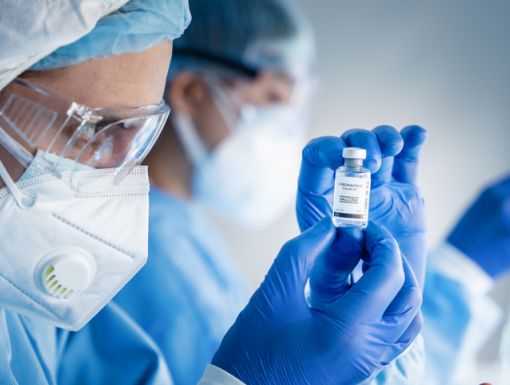
Is the COVID-19 Vaccine Safe for Transplant Patients?
As the COVID-19 vaccine continues to roll out, we know that transplant patients wait in great anticipation. The Centers for Disease Control and Prevention’s advisory committee on immunization practices has made recommendations for certain groups for early vaccination in a phased distribution. States can define their own prioritization scheme, affecting how priority is determined and it can differ state by state. Limited supply also can vary between states as we hope for a more stable supply. Here are some of the most common questions concerning COVID-19 vaccination among the transplant community.
Is the COVID-19 vaccine available for transplant patients?
The U.S. Food and Drug Administration (FDA) has approved the use of the Pfizer and Moderna COVID-19 vaccines under Emergency Use Authorization. Transplant patients and candidates are considered “high-risk” for severe complications due to COVID-19. Although the timing is unknown, transplant patients may be included in the groups for early vaccination.
Is the vaccine safe for transplant patients?
The safety of the COVID-19 vaccine is still being studied in people who have received kidney, liver, pancreas, heart and lung transplants. However, it is expected that the benefits outweigh the risk. Transplant patients are at higher risk for developing a severe case of COVID-19 due to comorbidities (the simultaneous presence of two or more diseases or medical conditions) and immunosuppression, which is a partial or complete suppression of a person’s immune system. We encourage all transplant patients to speak with their doctor before deciding whether the vaccine is right for them.
Current data from COVID-19 vaccine trials that have been released supports the safety and efficacy of the vaccines. There have been no significant safety concerns for either the Pfizer vaccine or the Moderna vaccine. Over 37,000 people have received the COVID-19 vaccine during the Pfizer and Moderna vaccine trials with no significant side effects. The benefits of vaccination greatly outweigh the risks of not being immunized.
How effective is the COVID-19 vaccine in transplant patients?
Both the Pfizer and Moderna vaccines have 94.1%-95% efficacy in preventing COVID-19 in people with a normal immune system response. Studies still must be conducted among organ transplant patients to determine the effectiveness. It is possible transplant patients may have a lower antibody response than people without transplants.
What are the side effects?
- Similar to the flu shot, the vaccine is administered into a large muscle in the upper arm. Like with any vaccine, allergic reactions may occur. Some may experience mild fever, soreness, muscle aches, headaches, chills, fatigue/tiredness, muscle or joint pain, redness and/or swelling at the site of administration. These are signs of an immune response to the vaccine and are expected in some patients.
- Based on the FDA emergency use authorization data, possible side effects have been more prominent after the second dose.
- If you have pain or discomfort, you can take your usual pain reliever or talk to your pharmacist about taking an over-the-counter medicine, such as ibuprofen or acetaminophen.
- To reduce pain and discomfort where you got the shot, you can apply a clean, cool compress over the area. To reduce discomfort from fever, drink plenty of fluids.
When should a transplant patient receive the COVID-19 vaccine?
It is recommended that all transplant patients and their immediate household members get the vaccine as soon as it becomes available to them.
When should a candidate for transplantation receive the COVID-19 vaccine?
Transplant candidates should get the vaccine while waiting for transplantation. The candidate should receive both doses at least two weeks before transplantation if possible. If the patient is unable, it is recommended to get the vaccine one month to six months after transplantation. If a candidate received a transplant after their first dose, patients should wait to receive the second dose four weeks after transplantation.
If a candidate received a transplant after their first dose, patients should wait to receive the second dose four weeks after transplantation.
Should a transplant patient still receive the vaccine even if they have already contracted COVID-19?
Yes, transplant recipients should receive the COVID-19 vaccine regardless if they have contracted COVID-19. Transplant patients can get infected again due to a low immune response or fading immunity from the first infection. If the transplant patient currently has COVID-19, they must self-isolate and wait for all symptoms to have passed. Vaccination can wait 90 days. If a transplant patient contracted COVID-19 between doses, they should wait till after the symptoms have cleared to get the second dose.
Will I still have to mask and social distance after I get the shot?
Yes. Remember, it takes time for your body to build protection after any vaccination. COVID-19 vaccines that require two shots may not protect you until at least a week after your second shot. It’s important for everyone to continue using all the tools available to help stop this pandemic as we learn more about how COVID-19 vaccines work in real-world conditions. Until we reach herd immunity and the majority of the United States has been vaccinated, we will need to continue to practice social distancing, handwashing and wearing masks. These are the best ways to reduce your chance of being exposed to or spreading the virus until we end this pandemic.
Do transplant patients need to wait to receive other vaccines such as the flu shot?
The Centers for Disease Control and Prevention’s advisory committee on immunization practices recommends that the COVID-19 vaccine should be administered alone with a minimum of 14 days before or after receiving other vaccines.
To learn more about organ transplants, please visit: https://www.ochsner.org/servic...

